 |
|
|
 |
 |
 |
 |
| CADET MEMORY – 1956 |
|
| CADET MEMORY – 1956
Way back in the days of yore when the membership of the Cadets was predominately locally based, and therefore available for performances year-round, parades were a major source of income for the corps, and the Cadets participated in them regularly.
Because of the Cadets’ notoriety they were usually invited to participate in most of the major ethnic parades in Manhattan, as well as other major New York City and national events. There were a significant number of these parades, and they commanded sufficient area interest to be televised, which further increased the Cadets’ exsposure and reputation. It was a win-win situation. The corps made money, their fame and reputation was well-served, they made their home communitiy proud, they enabled family and friends to see them “in the spotlight,” and they were, for most Cadets at least, a lot of fun as they marched down Fifth Avenue enveloped in the cheers of spectators packed along the avenue.
There was, to mention just a few, St. Patrick’s Day (Irish), Columbus Day (Italian), Steuben Day (German), Pulaski Day (Polish), Salute to Israel Parade (Jewish) and many, many others. These parades had a combined spectator and television viewing audience in the tens of thousands. In addition, many dignitaries were on hand both in the reviewing stand and on the steps of St. Patrick’s Cathedral (where the presiding Cardinal was usually in attendance), so the corps had an opportunity to impress not only the general public but important VIPs who over the years came to know and support the corps on many levels.
Photographic coverage in the major New York City newspapers quite often featured photos of the Cadets in these various “headliner” parades.
The photo accompanying this glimpse into our past was taken at the 1956 St. Patrick’s Day parade held on Saturday, March 17, 1956 as the corps was marching past the reviewing stand. It was taken by a New York Daily News photographer, and was printed as the entire front page on the next days’ edition, Sunday, March 18th. The Irish Harp was inserted by the photographer to frame our drum major.
|
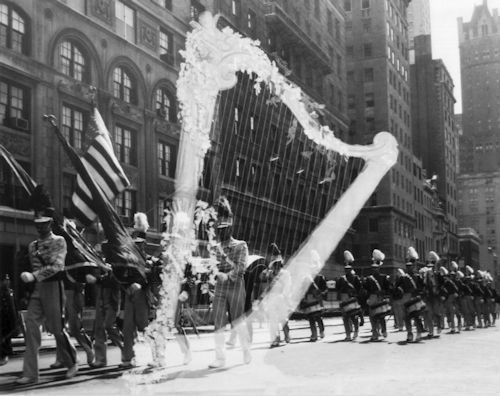 |
| Click on photo for larger view. |
|
Tony “Bart” Bartello was our newly appointed drum major, and this parade was his very first appearance and his very first time in uniform as drum major of the Cadets. Not bad for a first appearance to be featured on the front page of a major NYC newspaper. Another proud moment in the history of The Holy Name Cadets, and an especially proud day for Drum Major Tony Bartello.
|
|
 |
|
 |
 |
   |
 |
|
 |
 |
 |
 |
| CADET MEMORY - 1960s |
|
| (Note: This letter was written to a drum corps publication by Vern Johansson, famed drum major of the Canadian National Champion Toronto Optimists. Vern remains a friend, supporter, and donor to The Cadets to this day, and we are honored that he continues the friendship between The Optimists and The Cadets over so many years. Thank you Vern.)
|
CADET MEMORY – 1960s
GARFIELD: THE REAL SPIRIT OF DRUM CORPS
By Vern Johansson, Drum Major, Toronto Optimists.
“Friday evening, July 21, the Optimists loaded up their vehicles for their second trip to Garfield, New Jersey and the 20th Annual Garfield Invitational Championships. This is one of the most friendly towns our corps has ever had the privilege of visiting.
Saturday morning at approximately 10:00 AM two busloads of tired, haggard Optimists pulled into Garfield and were accepted into members’ home with overwhelming hospitality. As they told us, “The town is yours.” And it truly was. Being billeted with such fantastic hosts is twice as enjoyable as staying in a hotel.
All the members went home to get freshened up for the parade in the afternoon, then back at the school and into uniform. As we marched in the parade, the crowd applauded us as soon as our Canadian flag came into view. It was as if we were the hometown corps. This was Garfield’s 50th Anniversary as a city, and we were more than proud to march in a parade honoring them.
It’s a wonderful feeling to travel 600 miles and have so many people recognize you. The parade was long and hot, but the graciousness of the people of Garfield took the friction from the air
Another mode of hospitality was shown when all the participating units were supplied with free food and drinks after the parade. To carry this even further, they supplied us with transportation back to the dressing rooms.
Due to rain our rehearsal was cancelled briefly, but our hosts stayed right with us and waited until we were finished. The majority of them even stood in the rain and cheered us on.
In the evening show we were flabbergasted when our hosts organized cheering sections for us. It wasn’t as if they were trying to play host, but they were all accepting us into their families.
After the contest we were allowed to do anything we wanted. We weren’t pressured into going out or staying in. Our wish was their command.
Many of our members presented their billets with Centennial gifts commemorating Canada’s 100 years as a nation, and the hosts were deeply impressed.
Sunday morning our hosts were up early preparing substantial meals for us before we left. They also packed lunches in case we didn’t have time to stop. We played our repertoire for them as a small token of appreciation for all they had done for us.
PEOPLE OF GARFIELD AND MEMBERS OF THE GARFIELD CADETS: We of the Optimists send you our heartfelt thanks for showing us the REAL SPIRIT of drum corps.
Vern Johansson, Drum Major
Toronto Optimists Drum & Bugle Corps
|
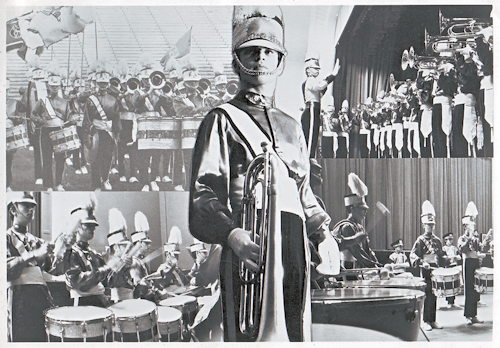 |
| Click on photo for larger view. |
|
The Toronto Optimists, Canadian National Champions, promo photo designed by their Director Don Daber (Don also designed a promo photo for The Cadets in 1971 in the same format).
|
|
 |
|
 |
 |
   |
 |
|
 |
 |
 |
 |
| CADET MEMORY - 1971-72 |
|
| Every so often our website receives something unexpected that unleashes powerful memories and a great deal of emotion. Dee (Kolbusz) Schlachter recently sent us these photos taken during the 1971 and 1972 seasons. Those two years were especially eventful for the Cadets, with highs and lows that I don't think anyone involved will ever forget. Dee, and Judy Tomko were our Color Guard Captains in 1971, followed by Dee and Patti Heinz in 1972. with Rich Chirichella and Jim Messina drum majors in 1971, followed by Jim Messina and Steve Bodek in 1972. There are still some memories of that period that are too sad and personal to be shared, but as time passes it somehow helps to remember . . . because to forget would be the worst tragedy of all. Some of those memories and the deep sorrow forever with us will be in evidence at the 75th Anniversary Memorial Mass to honor all our fellow Cadets who are no longer with us except in our hearts. The Mass will be held at the Church of The Most Name, Marcellus Place at the corner of Passaic Street, Garfield, NJ, on May 24th at 10:30 AM. All are welcome to attend.
|
As a little background for those not familiar with those Cadet years; 1971 was the year we introduced our "American the Brave - 1776," the first total show concept program, followed by the "No More War" show in 1972.
|
These photos sent to us by Dee are so powerful to those who appear in them, no explanations are necessary. For others we will attempt to provide a little background to allow you a peek at the history we were living at the time the photos were taken.
|
The first two photos are of our championship winter color guard instructed by Pete Emmons (yes, that Pete Emmons). They are shown performing their "silent drill," which was a radical departure from the format used by their competitors. All the guards they competed against used recorded music or percussion to keep the tempo for the performers. The only thing you heard during a Cadets' performance was the sound of their boots hitting the wooden gym floor on which they were marching. It was so difficult to perform and so masterfully performed, they commanded the full attention of everyone present, both spectators and members of other guards.
|
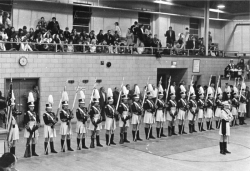 |
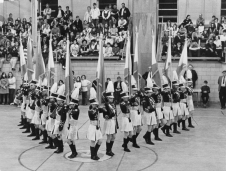 |
| Click on photo for larger view. |
|
The next full color photo is of Dee in uniform. It should give you an idea how the Cadets got the reputation for having the most beautiful girls in drum corps.
|
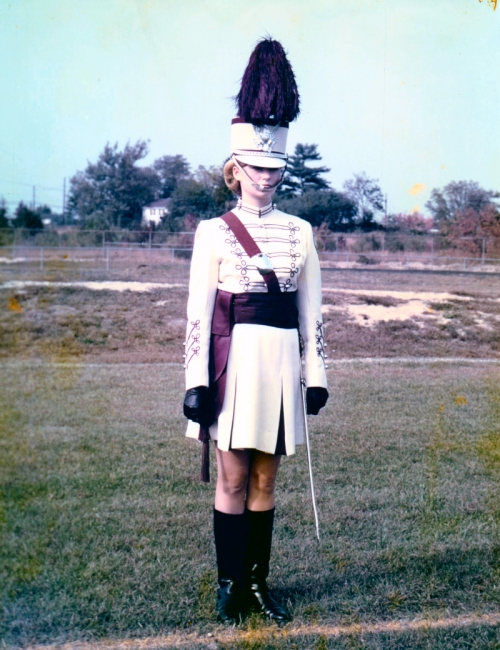 |
| Click on photo for larger view. |
|
The next photo looking left to right is Jim Messina, Steve Bodek, Patti Heinz, and Dee Kolbusz. Many contests in that era attempted to inflate their importance by calling themselves one kind of championship or another; which they further embellished by presenting the winner with a championship flag and the biggest trophy they could afford. It may have been a bit over the top, but it sure made for great pictures. Greg Cinzio said this was taken at the Garfield Invitational, but I don't think we were ever able to present trophies that big and expensive on our budget.
|
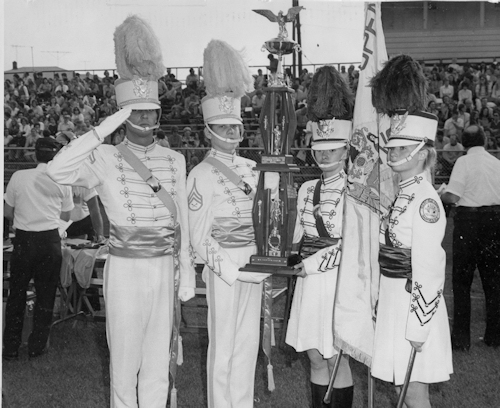 |
| Click on photo for larger view. |
|
Speaking of great pictures and beautiful people, it would be hard to beat the next combination. Sort of an informal/formal shot taken on the front steps of Garfield City Hall. Looking left to right, Rich Chirichella, Dee Kolbusz, Judy Tomko, and Jim Messina. One of the drawbacks of wearing the white uniforms is that you have to pose for a heck of a lot of photos.
|
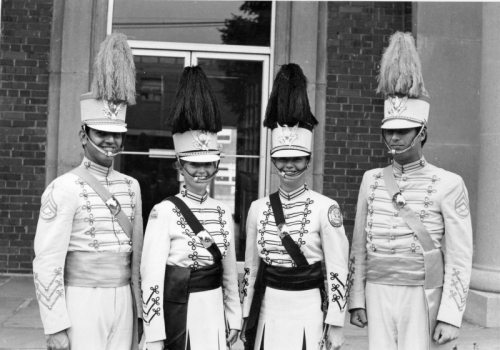 |
| Click on photo for larger view. |
|
The next photo is a once-in-a-lifetime classic. That's Dee and Steve riding in a convertible driven by Steve's Dad, Stan Bodek. The occasion was the 1972 Memorial Day Parade in Garfield. Sandwiched between Dee and Steve is one of our American Legion Silver Drums, emblematic of The National Championship. Every time we passed any area of importance, like Holy Name Church, the reviewing stand, someone's Mother, or a dead spot with no spectators . . .Dee and Steve would stand up in the car and salute. You might not have noticed but Cadets in white uniforms tend to salute a lot, even when they're not posing for photos.
The Cadet's contingent was fronted by the corps, with Jim Messina and Judy Tomko alternating riding and marching with Dee and Steve. The corps was followed by the convertible in the photo. That was followed by a flatbed truck with every trophy known to man affixed to it. The flatbed was followed by the corps' truck with mounts on the front bumper containing the ten national championship flags. The truck was followed by The Plebes, our feeder corps, and bringing up the rear was our three buses (amazingly they didn't break down).
The idea was to dazzle the City and show them what they would be losing if we left (which we were very close to doing if Garfield didn't offer more support). We got just the opposite reaction from what we would have liked. The politicians on the reviewing stand looked, were appropriately dazzled, and decided if we had all that stuff we certainly didn't need anything more from them.
We impressed all the spectators though, and when we finally were forced to relocate there were many Garfield citizens who were very unhappy to see us go.
|
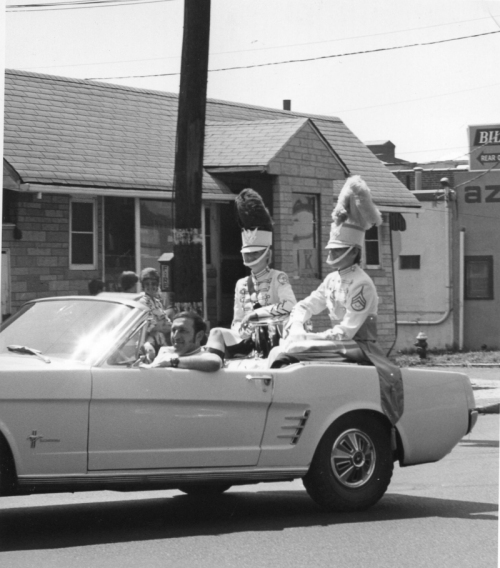 |
| Click on photo for larger view. |
|
The final two photos are of the Cadets performing. One was taken during the 1971 "America the Brave" show. They dazzled me then, and they dazzle me to this day. It's now thirty eight years later, and I still get chills listening to that 1971 show on CD. So, just a tiny bit late I'd like to say "Thank you Cadets." What a corps!!! The shot of the end of the presentation of the colors was taken in 1970 and was the photo used in the Comptons Gold Edition Encyclopedia.
|
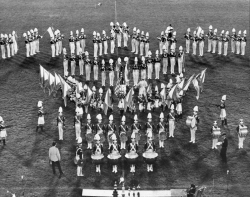 |
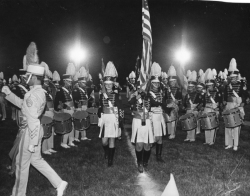 |
| Click on photo for larger view. |
|
To close out this wonderful trip down memory lane, the coin shown below was issued by the Franklin Mint to honor our American the Brave - 1776 show.
|
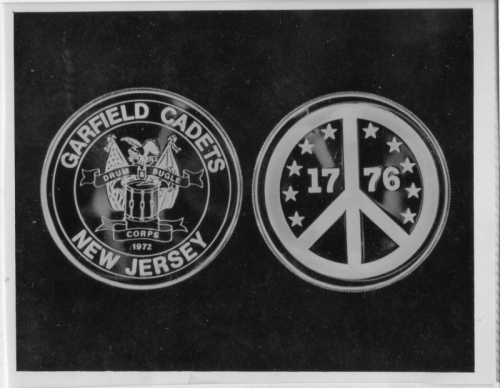 |
| Click on photo for larger view. |
|
|
 |
|
 |
 |
   |
 |
|
 |
 |
 |
 |
| 1934 CADET MEMORY |
Prior to practicing at Holy Name Church right after the Cadets' founding in
1934, both John Baumfalk - age 89 (our first DM and horn instructor), and his
sister Nellie - age 93, recall that John would teach 30 to 40 cadet buglers in
the basement of their home. As Nellie recalls, it was pretty loud and sometimes
their neighbors complained.
|
Both very clearly remember that the Elders of the Dutch Reformed Church (where
they were members), would pay a visit to their mother to lecture her about John
performing or practicing on Sundays, as well as about his being so involved with
a Catholic group. They said that the elders would really give "heck" to
their Mom, but she stood up to them on behalf of John. Their Mom would usually receive
a visit on Monday or Tuesday after any Sunday that John wasn't in church, and
this happened fairly frequently. John still gets pretty emotional about how his
Mom supported him because she knew that this was something he really loved to
do, and was exceptionally good at also.
|
| submitted by Judith Kasper (family member) |
 |
|
 |
 |
   |
 |
|
 |
 |
 |
 |
| 1934-72 CADET MEMORY |
| THE CADETS' ROYAL FAMILY |
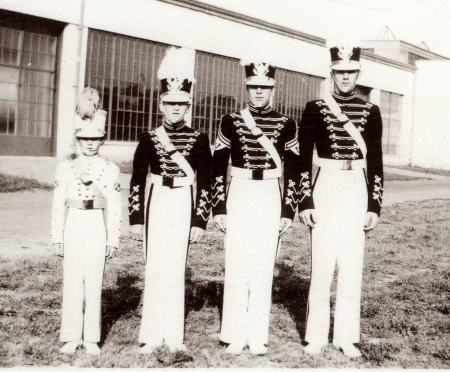
Art Mura (L) - Lou Mura (C-L) - Al Mura (C-R) - Marcel Mura (R) |
| Members of the Mura Family of Garfield were members of the Cadets starting with Corps' founding in 1934 until the early 1970s' Members of the family past marching age were active as booster club members and officers, fund raisers, quartermasters, financial contributors and volunteers wherever, whenever, and however they were needed. |
| Three Mura family members were founding members; brothers Albert (Al), Charles, and Marcel (Marc). Three other brothers were marching members in the early years; Arthur (Art), Edward, and Louis. They were followed by nephews; Dennis, Henry, and Roger, and niece Susan (Sue). |
| As if this wasn't enough, the Mura family gave us four Drum Majors (check Drum Major page for photographs); Albert, Arthur, Louis, and Dennis. |
| Al Mura later became horn instructor and arranger for the Cadets from 1949 through 1954. |
| In the first 38 years of the Corps' existence every single Cadet during that period marched with a Mura. |
| Information confirmed by Al Mura |
 |
|
 |
 |
   |
 |
|
 |
 |
 |
 |
| 1940 CADET MEMORY |
 |
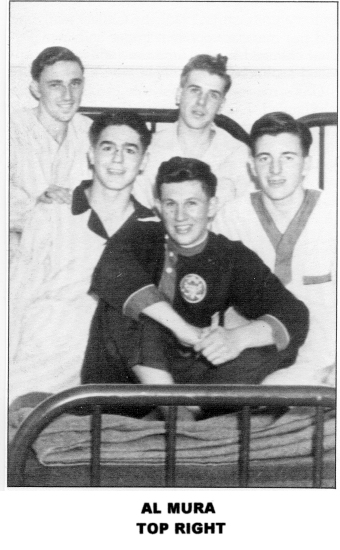 |
(above) By 1940, the Cadets were renowned all along the eastern seaboard. They were asked to perform not just in competition, but at parades and festivals like the 1940 World's Fair. |
(left) Status: Boston 1940
Being a Holy Name Cadet brought lots of status to the members. Because membership requirements were so strict, Catholic boys were switching parishes just so they could be in the Corps. Protestant boys were converting to Catholicism just to be numbered among the Holy Name Cadets. Being a Cadet eventually became such a popular thing that some members even wore Holy Name pajamas. |
| (below) Cadets relax at the American Legion Convention after capturing their first National Title. BOSTON 1940 |
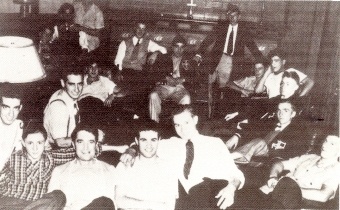
|
| Submitted by Al Mura, 1939-42 DM 1940 - First National Championship |
 |
|
 |
 |
   |
 |
|
 |
 |
 |
 |
| CADET MEMORY - 1940S - 1950S |
|
| |
photos courtesy of Bill McCullum
|
During the decades of the 1940s and 1950s , while still an all-male corps
comprised exclusively of boys from the local area; most if not all of a Cadet’
s social life was corps related. During the winter off-season one of the most
well-liked of the many social events were the formal military balls. These
were sponsored by the individual corps , with others corps often invited to
participate. There were also military balls sponsored by the competitive
circuits to which all member corps were invited. At most of these events the
young men wore their corps uniform, and the young ladies wore formal gowns
The Cadet’s Military Ball also featured a military style grand march, which
was an entrance ceremony with couples appearing in formation. This was led by
the drum major and his female guest, followed in order of rank by the color
guard captain(s), section sergeants, etc. It was considered a very big deal
among the young people of Garfield., far surpassing in social importance the
proms of the local high schools. The young ladies receiving a bid considered
themselves quite fortunate.
These events pretty much came to an end at the conclusion of the 1950s, but they
are fondly remembered by all who marched during those years.
FHNSAB...
|
 |
|
 |
 |
   |
 |
|
 |
 |
 |
 |
| CADET MEMORY - 1950s - 1960s |
|
| 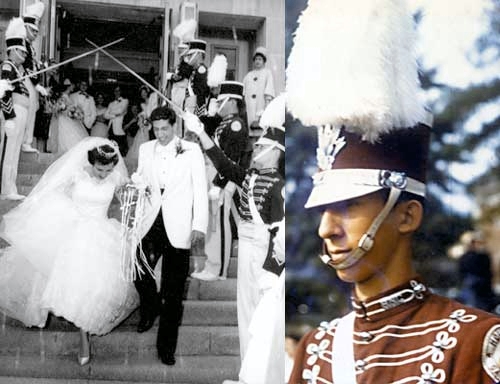 |
Over the years there have been a number of Cadet Military Weddings.
|
The first recorded Cadet Military Wedding was accorded to Cadet Al Mura and his
bride. Al was a founding member of the Cadets, and our 1940 National
Championship Drum Major. In addition, he was horn instructor for the Cadets
during the early 1950s. It was during this latter period that the wedding took
place at the Church of the Most Holy Name in Garfield.
|
The wedding photo illustrated is from the wedding of Cadet Tom Adamo and his
bride Judy, held in Blessed Sacrament Church in Paterson, NJ in the early 1960s.
Crossed sabers were held overhead by the Cadet honor guard as the bride and
groom exited the Church. Cadets were also groomsmen for Tom.
|
The honor guard at Judy & Tom's wedding consisted of: Cadet Paul Arthur (1957-62), Cadet Don Koch (1957-61), Cadet Richard DiCrosta (1958-61), Cadet Dan Raymond (1959-63), Cadet Tom Sands (1956-61), Doug Tenis (58-62), Roger Pratschler (55-62), Matty Malkiewicz (56-61), Ray Pych (57-63) , and Hugh Mahon (60-61).
|
It was a tradition at Cadet weddings for the groom and his Cadet groomsmen to
wear corps tee shirts under their tux shirts. Don Angelica honored this
tradition at his wedding to his wife Pat in the early 60s, as did his best man,
Dave Shaw, and his groomsman, Hugh Mahon.
|
Sadly there have not been any recent Cadet Military Weddings, but they remain a
part of our history and heritage. For Holy Name shall always be...
|
 |
|
 |
 |
   |
 |
|
 |
 |
 |
 |
| CADET MEMORY - 1954 |
|
| 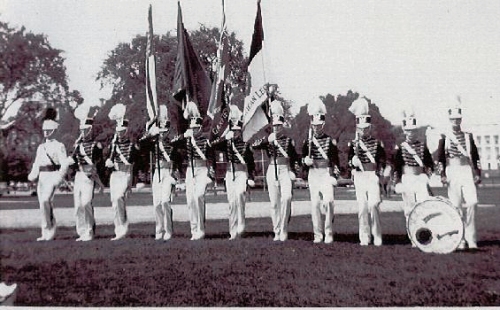 |
During the Cadets' all-male years we often entered a competing color guard in American Legion State and National Contests. We also competed, usually very successfully, in winter color guard circuits along the Atlantic Seaboard, from New England to Maryland.
|
The Cadets' competing color guards were composed, for the most part, of horn players and drummers from the ranks, rather than members of the corps' guard. The corps' guard during those years was often used as a first-step position for new Cadets entering the corps. Many Cadets would march in the guard for a year before moving on to become drummers or horn players.
|
The photograph here attached was submitted by Bob Bielen, the Color Guard Captain on the far left. It was taken at the 1954 American Legion National Championship Color Guard Competition in a park directly across from the White House in Washington, DC. The White House is visible behind the bass drummer on the far right.
|
The photo was taken with a fixed focus camera with the lens focused on the center, blurring the peripheries. It's difficult, therefore, to identify everyone in the photo. Those we have been able to identify are left to right: Bob Bielen, captain - Herb Bonin, rifle - Howard Steidel, rifle - American Flag, unidentified - American Legion Post Flag, unidentified - Holy Name Flag, unidentified - Dave Shaw, American Legion National Championship Flag - Richard Santo, rifle - rifle, unidentified - Robert Takacs, no equipment - Paul Scillia, cadence drum.
|
Anyone correctly identifying all the Cadets in the photo will receive a copy of the photo and the undying love of Bob Bielen. Other Color Guard memories, of the "stud-squad" competing guard in white shorts, and the championship all-girl competing guards, instructed by Pete Emmons, will be posted soon.
|
 |
|
 |
 |
   |
 |
|
 |
 |
 |
 |
| CADET MEMORY - THE MAROON SMOCKS |
For many years the Cadets, when not on the field performing, wore a distinctive uniform cover known as "the smocks." This unique garmet was originally designed to protect the uniform and keep our white pants clean. During those years Cadets would don their uniforms well in advance of their assigned appearance time. Once in uniform Cadets remained in full uniform, with the exception of shakos and gloves. Tunics were not removed or collar buttons opened. We were very much aware that the impression we made on the audience or members of other corps began long before we appeared on the field in competition. Once in uniform It was not uncommon to be released to meet with friends or family, sit in the stands in a block, or move about the stadium without restrictions. Similarly, after competing the Cadets remained in uniform, with smocks, awaiting the contest finale (full military retreats).
| 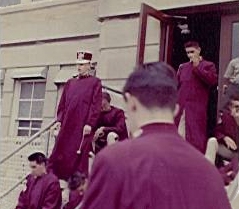 |
|
These smocks were usually collected by our quartermasters when we lined up to take the field, and on occasion were worn onto the starting line before being removed and handed off to quartermasters moving down the line.
|
There was, in addition to uniform protection, another reason for wearing these smocks. Part of the Cadet's credo was that the performance was not exclusively the time we spent on the field in competition. A large part of the Cadet mystique during that period was that everything we did, as Cadets, in uniform or out, was part of the performance and part of our Cadet consciousness. The smock was an element of that off-field performance. It attracted attention, it set us apart from other corps, and it enhanced our presence. When traveling to contests we were expected to dress neatly, though we had no required special traveling uniform such as those worn by Scout House (who we were fortunate to establish a close relationship with many years later). We were expected to exhibit the Cadet image in our personal behavior and appearance, which was something younger Cadets tended to absorb as a rookie, rather than a formal set of restrictions imposed on us by the adult administration.
|
The Cadets no longer wear smocks, due primarily to the in-and-out nature of the competitive experience in the modern era. They remain, however, a part of our history and heritage, and most alumni from the generations in which the smocks were worn, would very much like to see them reintroduced. The performance, with smocks or without, is still much more than the time spent on the field in competition; and the modern-era Cadets are demonstrably very cognizant of that fact.
|
|
| |
 |
|
 |
 |
   |
 |
|
 |
 |
 |
 |
| CADET MEMORY - 1957-63 |
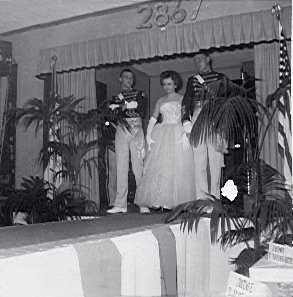 | 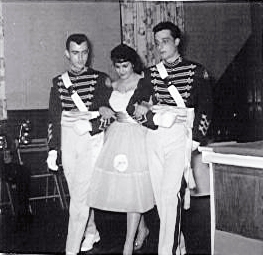 | 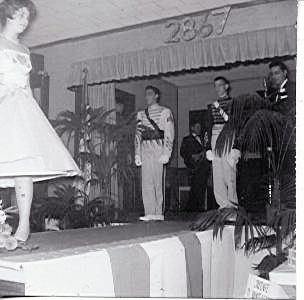 |
Greg Zwarycz (L) - Doug Tenis (R).
| Ken Samara (L) - Carmine Reddiconto (R).
| CG Ct. V. Randaisi (L), G. Hertzchuch (R).
| |
While still an all-male corps in the late 50s and early 60s, the Cadets were often called upon to provide escorts for beauty pageants, special events of various types, political and patriotic occasions, fundraisers for charities, sweet sixteen parties, an occasional cotillion, and a great many other occasions. Requests were probably directed to the Cadets so regularly in large part because of the appeal of our uniforms, our reputation, our military persona, and our experience with these functions. There was never a shortage of volunteers from the Cadets, because of the opportunities provided to meet any number of lovely young ladies. The most sought-after assignment of all was the Miss Drum Beauty event in Stillwater, Minnesota. To this day if you mention "Stillwater" to Cadets who marched those years, you will see eyes light up and smiles that stretch from ear to ear. The Cadets remember the beautiful young ladies of Stillwater very well, and we hope we are remembered fondly in return.
|
 |
|
 |
 |
   |
 |
|
 |
 |
 |
 |
| CADET MEMORY - 1959 |
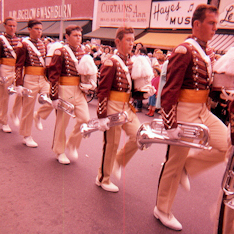 | 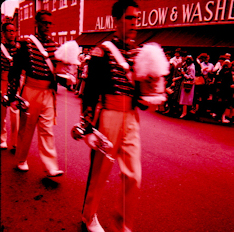 | 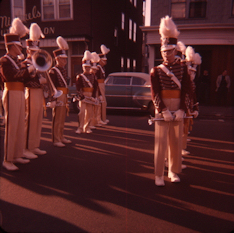 |
St. Mary’s Cardinals
| St. Mary’s Cardinals
| St. Mary’s Cardinals
| |
Following the dissolution of the Holy Name Cadets by the Pastor of Holy Name Church, our uniforms were offered up for sale to the highest bidder. The successful bid came from a corps we held in very high esteem for many years, St. Mary’s Cardinals from Beverly, Massachusetts. We do not know the reasons behind their decision to purchase them, but assumedly they believed that our corps would not continue to function and the uniforms, therefore, were no longer something we would need. We do recognize that there was no malicious intent, and in fact once they fully understood our situation they handled themselves with great tact and sensitivity, further strengthening our high regard for them, and hopefully their regard for us. They made it very clear in many different ways that they were very uncomfortable wearing the uniforms, and did not wish to add to our emotional burden.
We did not, of course, particularly enjoy seeing someone else in “our” uniforms, but we were assured that it would be very short term., and it was. We were always kind of curious though why they bought them considering how old and worn out they were, and how badly they smelled from years of Cadet use. Conversely if St. Mary’s hadn’t purchased them you can bet that some other corps would have, and we might have faced an entirely different attitude totally lacking in respect for the historical significance of the trademark uniform of the Cadets..
So, in a strange way, The Cardinals (now no longer active) and The Cadets share a bond of sorts, through the brotherhood of mingled perspiration. The Cardinals, though no longer fielding a corps, have a very active alumni association that still sponsors a contest every year, and more often than not The Cadets are there competing. Our corps has a very special connection to the spectators at that contest, and we look forward to it every year. Life and circumstance can be very strange at times.
The photos shown are of the Cardinals parading in the Cadet uniforms.
|
 |
|
 |
 |
   |
 |
|
 |
 |
 |
 |
| 1962 CADET MEMORY |
In '62 I marched in the Plebe Corp for a couple of months or so along with Pete
Tummillo of Garfield (City of Garfield's major trumpet virtuoso...
almost as good as Angelica.) We were "pressured" out of the corp by the
Garfield Public School Music Director, a clarinet player by the name of Pat
LaNeve! If that name sounds familiar, it is; his nephew Mike La Neve
became one of our Snare drummers in the mid-Sixties. I think he marched
until 1968 when he was "drafted" by the group "The Happenings" to be
their new drummer! The guy was a "hound", if you ever needed a girl,
you just hung around LaNeve at a contest and he would be happy to share.
|
| Submitted by Chuck Sydoryck 65-70 |
 |
|
 |
 |
   |
 |
|
 |
 |
 |
 |
| CADET MEMORY - 1965 |
|
| 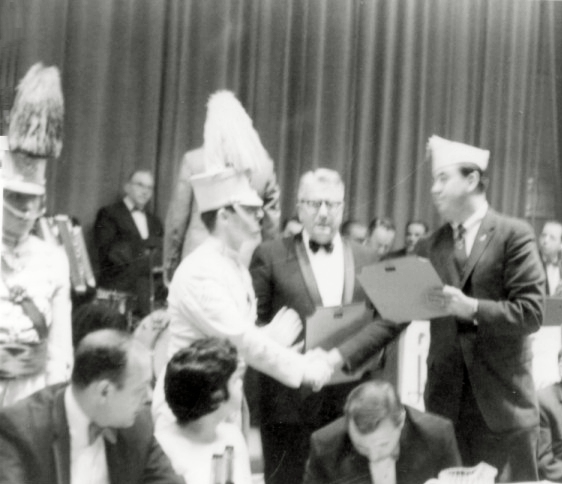 |
frnt LtoR:Hy Drietzer, Brenda Cluna, Carmen Cluna
rear LtoR: Eugene Klaus, Cadet CG Capt., Ken Samara, Cadet DM.
William Kemmerer, Cadet Director, American Legion official.
photos courtesy of Tony Vaccaro
|
In May 1965, the New York Skyliners held a banquet dinner/dance in the grand ballroom of the Hotel Roosevelt in New York City. The event had a number of features and the ceremonies included a performance by the corps, a presentation by an official of the American Legion of the 1964 National Championship flag to the Garfield Cadets. Also, the Skyliners presented an oil painting portrait of Garfield to the corps.
The Skyliners also used this event as part of an effort to recruit the fine young men of Garfield to join the Skyliners instead of going to Hawthorne where they had been going for many years continuing their relationship with Al Mura, Jimmy Costello and Les Parks who instructed and led both programs. In 1964 and 1965, Hawthorne and the Skyliners were engaged in bitter hostilities, refusing to compete with each other.
Present that evening were William Kemmerer, director of Garfield, the Cadet Drum Major, Ken Samara, and the Cadet Color Guard Captain, Eugene Klaus. Presentations were made to them of the Legion flag and a special oil portrait of Garfield done by Paul Allen, artist and Skyliner.
Speeches and comments were made by Henry (Lefty) Mayer, Skyliner Business Manager who was one of the most decorated soldiers of the Battle of the Bulge of WW 2. In real life, Lefty was a jeweller. Also speaking were Ralph Shur, Skyliner Director, and noted drill instructor. Ralph, along with many other Skyliners, became a member of the Caballeros for several years when the Skyliners did not compete.
Hy Dreitzer, Skyliner arranger and french horn player also spoke. Hy was working as a steam fitter at Con Edison while also playing in the company's excellent drum corps before joining the Skyliners. During the period of the Skyliners' inactivity, Hy also arranged several numbers for the Caballeros hoping to become the corps permanent arranger and replace Al Mura. Hy is widely given credit for coming up with the New York theme and emphasizing the 'Skyliner' identity as part of the reorganized corps. Up until then, the corps was known as Garbarina-Mazarakos, named for 2 deceased former members. Another speaker was Carman Cluna, Skyliner drill instructor and baritone player. Carman worked in sales in the garment district and was married to a niece of Edye Gorme'.
Copyright 2008 - Tony Vaccaro
|
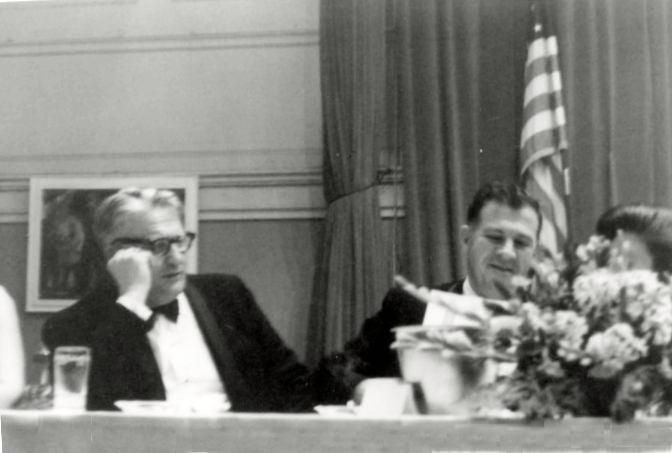 |
(l to r) Mr. Kemmerer, Lefty Mayer, Mrs. Louise Mayer obscured by flowers.
|
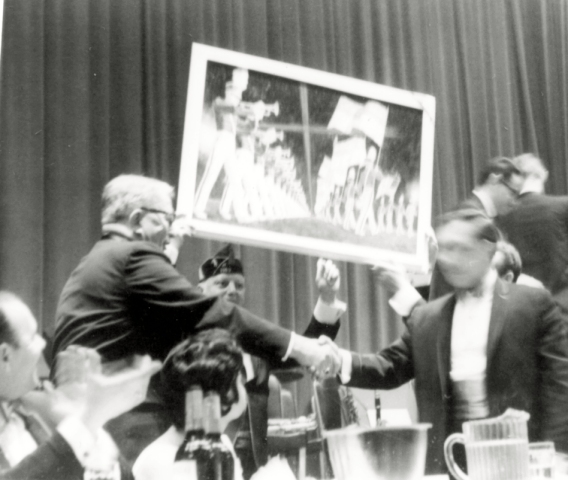 |
Hy Dreitzer, Kemmerer, Brenda Cluna, Sam Dibble (Skyliner Post official), blurred Cluna.
|
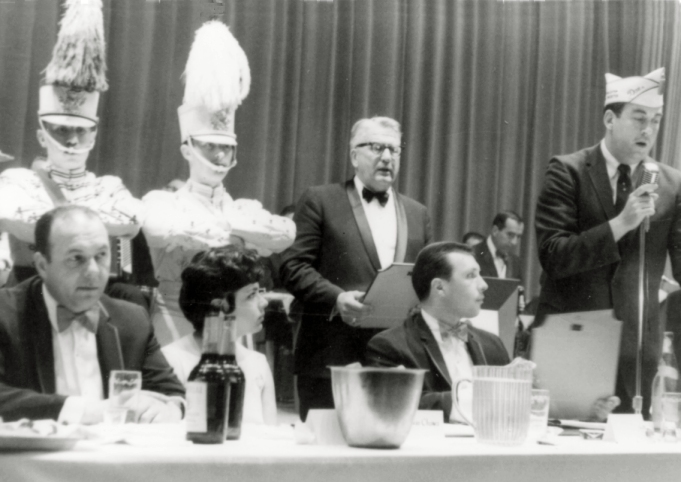 |
front LtoR: Hy Drietzer, Brenda Cluna, Carmen Cluna
rear LtoR: Eugene Klaus, Ken Samara,
William Kemmerer, American Legion official
|
 |
|
 |
 |
   |
 |
|
 |
 |
 |
 |
| 1969 CADET MEMORY |
Looking around, I didn`t see much in terms of a corps that held much interest for me, with the exception of Garfield - & the only thing that came to mind was "RESPECT", not to mention the fact that my mother ADORED them ! So there I was on a cold October evening in the Cadets Hall auditioning for the drumline. And, the timing simply could NOT have been any better even if I
had planned it ! Ahhhhhh, having Aunt Nell fit me up with my uniform that night, both welcoming me AND yelling at me at the same time for "slouching." It was a time of change there, the first year of females in the Corps. A year later, the PEACE symbol - which in my minds eye could only be eclipsed by the Troopers sunburst.
|
| Submitted by Dave Rice 69-70 (Cadet #55) |
 |
|
 |
 |
   |
 |
|
 |
 |
 |
 |
| 1973 CADET MEMORY |
The most challenging, rewarding, scary, toughest working year in my history as a Cadet. The year that almost wasn't. We went into March with 17 horns on the roster and went through five different horn instructors. If it weren't for the fact that Blessed Sacrament, the Woodsiders, and one or two other junior corps, disbanded, we would not have fielded a corps. With the determination of our horn instructors Dick Burns and John Schumacker, together with the extra rehearsals the members conducted at Frank Tambones House and at City Field in Garfield, we eventually pulled the show together (FHNSAB . . .).
|
Our first show in Bayonne, NJ (a total disaster - or, a good place to judge how far we really had to go). We just learned the music for the exit number, Bacchus, about a week before this show, and the drill, well, we were learning the drill right up to the day of the show. We eventually played this song quite well - however, not in Bayonne. I remember playing Bacchus going backfield. We were about to form a company front, facing backfield, preparing for the final charge - Heavy horns to the left of the drum line, and the sopranos to the right. We started to make our 8-count squad turn to ultimately face the front of the field, only to notice that the heavy horns had just moved forward in the charge - 4 COUNTS AHEAD OF THE SOPRANOS. That's right, half the corps ended 4-counts ahead of the other. I wanted to just hide my head in the dirt. I remember having member meetings afterwards to discuss what we need to do, and how much additional practice would be needed. We did what
was necessary. The instructors did their job during rehearsal, but the kids pulled the extra rehearsals needed to get the job done.
|
Bluegrass Nationals in Lexington, KY. Up until this show, we had been beaten by every local corps in the state (and other states). We were beaten by corps whose names I don't even remember. Hell, if you didn't beat us, early in the year, then your corps really needed help. Anyway, John Schumacher played the Bluegrass Finals GE Horn tape from Dr. Bernard Baggs for the horn line members. The only thing I remember about that tape was Dr. Baggs final comments as we were going backfield in the exit number, Bacchus. He said, "WELCOME BACK GARFIELD". I later told Dr. Baggs that his tape, with that comment, was the inspiration we needed to push forward. He had no idea how profound and important it was for us to hear that our work was rewarded with acknowledgement and appreciation.
|
Although we did not make the top 12 that year, I can honestly say that 1973 was the most difficult, challenging, yet rewarding year, I ever marched. And yes, Holy Name would continue to be
|
| Submitted by Greg Cinzio, 1967-77 |
 |
|
 |
 |
   |
 |
|
 |
 |
 |
 |
| 1986 CADET MEMORY |
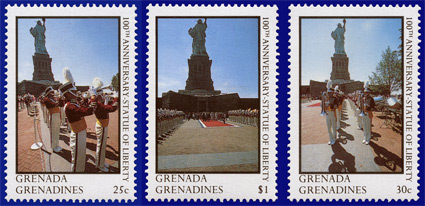 |
| Prior to the start
of the 1986 drum corps season, the Garfield Cadets performed
at the nationally televised rededication of the Statue of
Liberty in New York City. Photos from the performance were
later commemorated on a stamp for the Caribbean island of
Grenada. |
| courtesy of DCI Magazine, submitted by Greg Cinzio, 67-73 |
 |
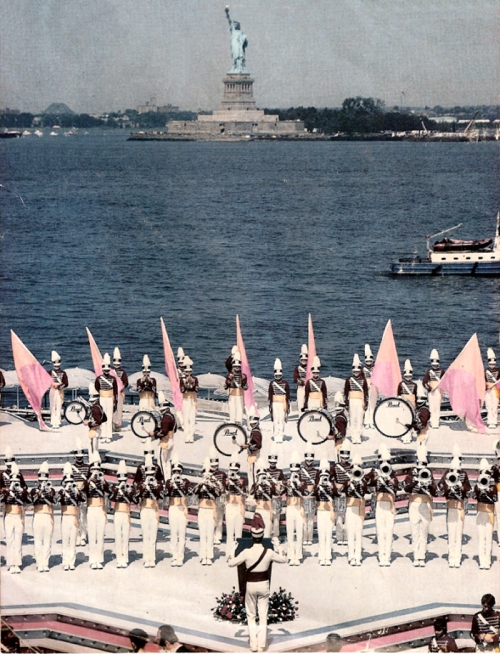 |
| photo submitted by Cathie Healey, 86-90 click on photo to enlarge |
|
 |
 |
   |
 |
|
 |
 |
 |
 |
| CADET MEMORY - 1988 |
|
| 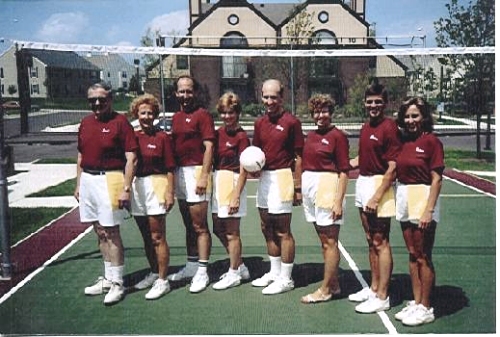 |
| Shown left-to-right: Doc Cinzio and his wife Sophie, Greg Cinzio and his wife Lynn
(nee Eikenberg) 1967-73 - combined years, Ken Cinzio and his wife Keren (nee
Gordon), 1972-78 combined years, Warren Corman and his wife Karen (nee Cinzio),
1977-84 combined years |
During "Doc" Cinzio's tenure as Director of the Cadets, 1977-79, all three of
his children, as well as all of their future spouses marched Cadets. In this
photo taken in Kansas City at the 1988 DCI Championships, the Cinzio clan
prepares for a killer volleyball game. This was the last time Dr. and Mrs.
Cinzio, and all of their family, were able to attend a DCI Championship as a
group. Growing families and burgeoning careers brought an end to the Cinzio
world-class volleyball era. We remain in approving awe, however, of the uniforms
chosen for the event.
|
 |
|
 |
 |
   |
 |
|
 |
 |
 |
 |
| CADET MEMORY - 1999 - 2007 |
|
| 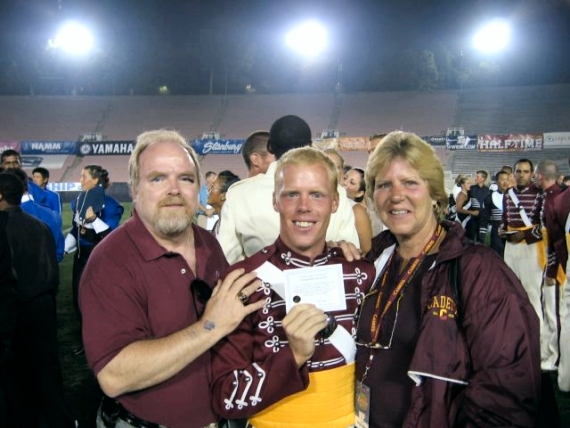 |
photos courtesy of Scotty McGarry
|
THE HEART OF A CADET BEATS IN THE CHEST OF A CADET DAD
A tribute to Michael Terry Sr., and his 2007-ageout son, and outstanding Cadet
soloist, Michael Patrick Terry.
Even though I was not fortunate enough to be a Cadet member during my
eligible marching years, I can relate to the deep feelings of family as I am
also a product of the drum corps experience as a charter member of the
Alabama Charioteers (1971-1975), a smaller Class A corps. I later served as
an instructor for the Imperial Guard from Evansville, IN (1979-1980), and as
Founder and Executive Director of Southwind Drum & Bugle Corps from
Montgomery, AL (1980-1982). I was Public Relations Director for the Memphis
Blues Brass Band, a drum & bugle corps (1982-1983) and returned to
Southwind in various functions including consultant to the BOD, tour
director, bus driver, instructor, and board member (1983-1997). When
Southwind opted to become a part of the Madison Scouts organization under
Scott Stewart in 1997, I ceased active participation with the corps. That
winter George Hopkins asked me what I was going to do the next season and
when I replied, "take a year off" - he said, "I don't think so - I need your
help with The Cadets." And that is how I became a member of the extended
Cadets family. My son, Michael Patrick, who had been touring with drum
corps since he was two, had become a Cadets fan in 1994 with the reprise of
the West Side Story show. He was obviously thrilled that we would be
touring with the Cadets!
In the winter of 1999, when Michael was 13, he asked to go through the
audition process for the corps to gain experience for when he became "old
enough to march." His mother and I agreed and were as surprised as he was
that he was invited back! The rest is history. Michael marched his first
year as a Cadet in the 2000 Championship year and for the next 8 years,
never considered marching anywhere else (even though he was heavily
recruited by other corps). Michael Patrick grew and matured into a magnificent
young man and a capable leader during his marching tenure with the Cadets. As
proud as I have always been of my son, I've never been more proud of him than when
I watched him age out of the Cadets after 8 consecutive years of hard work
and unwavering dedication as a marching member. And now, as a senior in
college, I am confident that he is well prepared to teach and mentor the
next generation of young musicians in large part due to the training he
received and role models that he was exposed to during his marching career
with the Cadets.
FHNSAB...
|
 |
|
 |
 |
   |
 |
|
 |
 |
 |
 |
| 2001 CADET MEMORY |
| MARC MURA: A DRUM CORPS LEGEND |
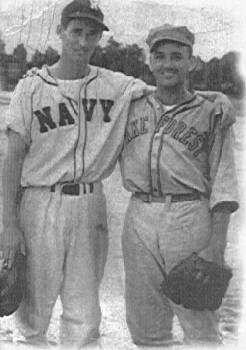
Ted Williams (L) - Marc Mura (R) |
| Stockton resident Marc Mura, 81, is one of the original founding members of The
Cadets and has stories relating to them from October of 1934. That year seven
14-year-old boys started a club in which they took turns drumming on a wooden
table and blowing into an old horn: this was the beginning of a drum and bugle
corps, The Holy Name Cadets - the forerunner of the Garfield Cadets. In 1950, as Vice-Commander of
American Legion Post #255, Garfield, N.J., Marc accompanied the Cadets to Los
Angeles, their last California visit prior to this evening. Now known as the
Cadets of Bergen County, they captured their eighth World Championship of Drum
Corps International last summer. Mura states, "Unlike basketball, football, or
other competitive sports which only last ten or twenty years, music penetrates
your entire body and soul, and stays with you your entire life. Sponsors of
Music Enrichment is pleased to honor Marc Mura as our special guest at the
23rd Annual Moonlight Classic, held this evening at the
University of the Pacific, Stockton, California, July 6, 2001. |
Note: Marc (Marcel) Mura passed away since this tribute was written. He remains
a part of The Cadets' history and heritage forevermore.
|
Submitted by Heritage Cadet Art Mura 1937-50.
Special thanks to Sponsors of
Musical Enrichment for their kind recognition of this revered Cadet. |
 |
|
 |
 |
   |
 |
|
|
